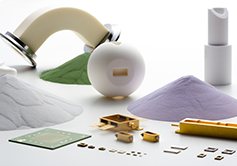Fine Ceramics, sometimes referred to as "advanced ceramics," are engineered materials that support the development of cutting-edge technology.
- HOME
- Characteristics of Fine Ceramics
- Electricity and Magnetism - Magnetism
Electricity and Magnetism (5)
Magnetism to Hold Magnetic Force
Magnets possess north and south poles and generate magnetic fields. Most ceramics are nonmagnetic, with ferrite being one notable exception.

Applications: Coils.
Description
Magnetic Properties
Ferrite is well known among Fine Ceramic materials for its magnetic properties. Ferrites are made by mixing and sintering iron oxide, manganese oxide and nickel oxide powders. Their primary uses include serving as magnets and magnetic coils in a wide variety of electronic circuits, and in electronic devices, such as transformers and loudspeakers.
The term "Fine Ceramics" is interchangeable with "advanced ceramics," "technical ceramics" and "engineered ceramics." Use varies by region and industry.
People who read this page also read.

Electricity and Magnetism (1)
Electricity and Magnetism (1)
Electrical Insulation to Inhibit Electricity from Passing Through
Electrical Insulation to Inhibit Electricity from Passing Through
Characteristics of Fine Ceramics

Electricity and Magnetism (2)
Electricity and Magnetism (2)
Conductivity to Allow Electricity to Pass Through
Conductivity to Allow Electricity to Pass Through
Characteristics of Fine Ceramics

Electricity and Magnetism (3)
Electricity and Magnetism (3)
Dielectricity to Accumulate Electricity
Dielectricity to Accumulate Electricity
Characteristics of Fine Ceramics

Electricity and Magnetism (4)
Electricity and Magnetism (4)
Piezoelectricity to Convert Electricity into Power/Power into Electricity
Piezoelectricity to Convert Electricity into Power/Power into Electricity
Characteristics of Fine Ceramics

Different Types of Fine Ceramics
Different Types of Fine Ceramics
Wide Variety of Products to Support both Industry and Society
Wide Variety of Products to Support both Industry and Society
Introduction to Fine Ceramics
If you want to use ceramics in business, click here.
Kyocera's Fine Ceramics products (All websites below open in a separate window.)
Product Category
 Semiconductor / LCD Processing Equipment
Semiconductor / LCD Processing Equipment
 Life / Culture / Industrial Machines
Life / Culture / Industrial Machines
 Wireless Communications
Wireless Communications
 Computer Peripherals
Computer Peripherals
 Environmental Preservation / Renewable Energy
Environmental Preservation / Renewable Energy
 Medical Equipment / Devices
Medical Equipment / Devices
 Single-Crystal Sapphire Products
Single-Crystal Sapphire Products
 Metallized / Vacuum Components
Metallized / Vacuum Components
 Electronics Industry
Electronics Industry
 Heaters
Heaters
 Piezoelectric Ceramics
Piezoelectric Ceramics
Search by Material
 Alumina
Alumina
 Silicon Nitride
Silicon Nitride
 Silicon Carbide
Silicon Carbide
 Sapphire
Sapphire
 Zirconia
Zirconia
 Cordierite
Cordierite
 Yttria
Yttria
 Aluminum Nitride
Aluminum Nitride
 Cermet
Cermet
 Mullite
Mullite
 Steatite
Steatite
 Forsterite
Forsterite
Search by Property/Characteristic


- Thermal Properties
- Coefficient of Thermal Expansion
- Thermal Conductivity
- Heat Shock Resistance

- Electrical Properties
- Insulation / Semiconductivity

- Chemical Properties
- Chemical Resistance










